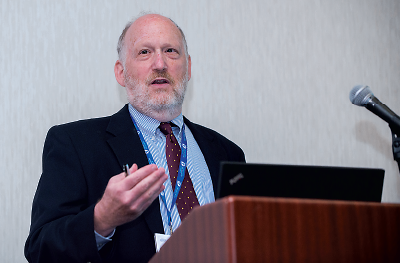Outcomes From AOT Studies Show Benefits of Program
Abstract
Amid controversy, one researcher lays out the evidence for the use of involuntary outpatient commitment in the community.
Does involuntary assisted outpatient commitment work?
The answer is, “it depends,” Marvin Swartz, M.D., a professor of psychiatry and behavioral sciences at Duke University School of Medicine, told an audience gathered at IPS: The Mental Health Services Conference in New York last month.

Marvin Swartz. M.D., a professor of psychiatry and behavioral sciences at Duke University, discusses the pros and cons of involuntary outpatient commitment programs at IPS: The Mental Health Services Conference in New York.
Swartz, who was the 2015 recipient of APA’s Isaac Ray Award, which recognizes outstanding contributions to forensic psychiatry or to the psychiatric aspects of jurisprudence, has spent over 25 years studying assisted outpatient treatment (AOT). As he described during the lecture given in connection with receiving the award, examining the effectiveness of AOT presents methodological challenges and the results have been mixed.
As Swartz explained, AOT is “a treatment plan wrapped in a legal order.” It extends the state’s civil commitment authority from the psychiatric hospital to a community-based mental health system. A court order requires a patient to comply with treatment and receive services but also implicitly requires that the mental health system treat the patient.
Failure of a patient to stick to the treatment plan violates the court order and typically results in a patient being transported to a hospital or other psychiatric facility for a mental health evaluation. However, it does not call for incarceration or “forced drugging in the community,” as some opponents have charged, said Swartz.
Critics of AOT have suggested that instead of mandating that patients receive treatment—which they say implicitly blames the patient for failures of the mental health system—the focus should be on improving the system itself and increasing outreach to patients in need. However, evidence suggests AOT can lead to improvements for some patients.
Swartz led the first randomized, controlled trial of AOT commitment in North Carolina, which compared the outcomes of patients with severe mental illness who received community mental health services through AOT with those who received comparable services without AOT.
The team found that individuals in AOT had fewer readmissions to the hospital and spent fewer days in the hospital if they received AOT for six months or more and they were provided consistent and frequent community services during the commitment period; they were also less likely to be violent or to be victimized.
Individuals who received AOT for less than six months, however, saw no benefit, even when combined with other outpatient services.
The introduction of an AOT program in New York in 1999—known as Kendra’s Law—brought with it a significant amount of funding to support AOT infrastructure and implementation. Investments were made in enhanced community services, intensive care management, assertive community treatment, and a single point-of-access program. Funds were also allocated for medication, drug monitoring, prison and jail discharge managers, and other services for people in the AOT program.
New York’s AOT program also created an opportunity for Swartz and colleagues to evaluate how a comprehensively implemented and well-funded program of AOT performed. Using an observational model with statistical controls, Swartz and colleagues analyzed data from Medicaid claims, case manager reports, and AOT to assess the program’s effectiveness (Psychiatric News, August 2, 2013).
Studying the New York state program was not easy, he said. For one thing, the people who were selected for AOT were a heterogeneous group and thus hard to match with controls. Additionally, a large number of cases came from New York City, creating potential geographic and cultural biases.
Swartz and colleagues also found that 80 percent of the people in AOT started in the program as they were released from psychiatric hospitals. Essentially, the program served as a stepdown from hospitalization for many—a form of conditional release and possibly a way for patients to get out of the hospital, Swartz explained.
Nevertheless, the increased access to services in the New York state program did improve a range of outcomes for enrollees, said Swartz. “We find consistent evidence that during AOT there is a substantial reduction in the number of psychiatric hospitalizations and in days in the hospital if a person is hospitalized,” Swartz and colleagues wrote in a report evaluating the New York program. “We also find that AOT recipients are far more likely to consistently receive psychotropic medications appropriate to their psychiatric conditions.”
In addition to its effects on patients, the program also influenced service provider behavior. The state monitored clinicians and phoned them if they were not meeting the prescribed standards of care, thus injecting an additional layer of accountability into the system.
“The question is not if AOT is effective, but can it be effective?” said Swartz. “It is a complex intervention that must be carried out in the community and is not easy to evaluate in a randomized, controlled trial. It can be effective if implemented well, provided with the necessary services, and given sufficient time to work.” ■



